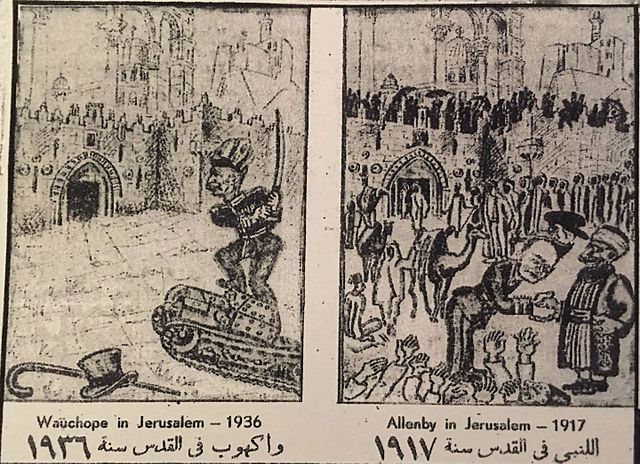1936–1939 Arab revolt in Palestine
A popular uprising by Palestinian Arabs in Mandatory Palestine against the British administration of the Palestine Mandate, later known as The Great Revolt or The Great Palestinian Revolt, or the Palestinian Revolution, lasted from 1936 until 1939, demanding Arab independence and the end of the policy of open-ended Jewish immigration and land purchases with the stated goal of establishing a "Jewish National Home".
British soldiers on an armoured train car with two Palestinian Arab hostages used as human shields.
June 1936 cartoon in the Arabic-language Falastin newspaper contrasting the actions of Wauchope in 1936 against those of Allenby in 1917
Feminist activist Tarab Abdul Hadi, organiser of the Palestinian Arab Women's Association.
Amin al-Husayni, Mufti of Jerusalem and leader of the Arab Higher Committee
The Arab Higher Committee or the Higher National Committee was the central political organ of Palestinian Arabs in Mandatory Palestine. It was established on 25 April 1936, on the initiative of Haj Amin al-Husayni, the Grand Mufti of Jerusalem, and comprised the leaders of Palestinian Arab clans and political parties under the mufti's chairmanship. The committee was outlawed by the British Mandatory administration in September 1937 after the assassination of a British official.
Members of the Arab Higher Committee, 1936. Front row from left to right: Raghib al-Nashashibi, Amin al-Husayni, Ahmed Hilmi Pasha, Gen. Manager of the Jerusalem Arab Bank, Abdul Latif Bey Es-Salah, chairman of the Arab National Party, Alfred Roke
Amin al-Husayni, president of the Arab Higher Committee meets with Führer of the Third Reich, Adolf Hitler.






